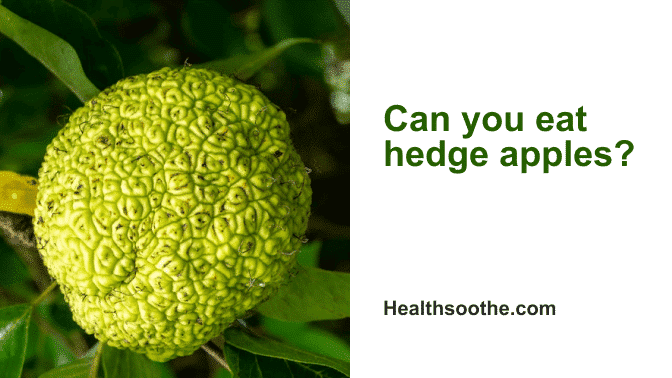The hedge apple, often referred to as the Osage orange or horse apple, develops from a tiny deciduous tree or a big shrub that gets up to 30 to 50 feet tall.
The hedge apple has an 8 to 15-centimetre diameter, is generally spherical, is bumpy, and turns brilliant yellow-green in the autumn. When it is cut or damaged, it releases sticky white latex.
It belongs to the [mfn]Plantae kingdom’s Moraceae fami[/mfn]ly, which includes the mulberry species. You may see these lovely and alluring fruits and wonder, “Can you eat hedge apple?” Unfortunately, hedge apples are not suited for human eating owing to their gummy latex secretions and woody pulp.
These fruits may be consumed by animals like chipmunks and squirrels. If they consume them, animals like cattle are likely to perish.
Due to their size and thick skin, they may induce settlement in the oesophagus, which may choke the animal and cause death.
Where Did Hedge Apples Originate?
Hedge apples are produced by the Osage orange, a deciduous tree (Maclura pomifera). The hedge apple tree is also known as:
- Bodak
- Bow-wood
- Horse apple and
- Hedge
You may have seen the hedge apples while walking to the grocery store and started to wonder how they got started. The Osage tree originated in the southwest, namely in [mfn]Oklahoma[/mfn], Texas, and Arkansas’ drainage basins.
Native Americans from the Osage Nation and the Cherokee were familiar with it because of its wood. The wood was used to make hunting bows, which were subsequently valued more than a horse and blanket.
Farmers and ranchers in the Midwest began to cherish it as it gained greater acceptance. Due to its strong thorns, it was utilised to create live fences, thus the term “[mfn]hedgerows[/mfn].”
Its value soared because it made fence posts that were more valuable than those used today and could withstand dampness and insects.
The trees were also employed by the early Americans as a barrier to keep wild animals out of their gardens and cornfields.
The hedge apple trees were severely clipped as they grew and produced a large number of intertwined adventitious branches. They thereby created a thick, thorny barrier hedge.
Until the advent of barbwire, this sort of fence was well-known and often used across the United States.
Read Also: 10 Amazing Health Benefits of Aidan Fruits
What are the Uses of Hedge Apple?
Maybe you’ve come across some hedge apples, but you should know better than to eat them. Thus, the query, what applications do hedge apples have? There are a few other applications you can look into despite their unpleasant nature. The hedge apple’s trees and leaves can also be helpful. Such uses comprise.
1. An Excellent Firewood Source
The hedge tree is unlike other trees because of its deep, sturdy roots and vivid orange bark. Bulldozer operators have sometimes said that it is more difficult to remove a hedge tree than an oak. Chainsaws have a difficult time cutting the timber. The wood burns hotter than any other wood after it has dried out.
2. Consumed by squirrels and chipmunks as food
Since they are hefty, have a wrinkled or rough surface, and turn yellow-green in the autumn, hedge apples are not appealing to both people and animals.
When the fruit is sliced, a sticky latex substance is released, irritating the skin. The tree’s name, Osage orange, comes from the orange taste it also exudes.
Because they are not intimidated by their appearance, squirrels and chipmunks rip through them to consume the interior seeds. On the other side, cattle may suffocate from them.
3. Used to Keep Away Insects
Glossy leaves, branches, and tree bark are often unappealing to many insects. The hedge fruit also fits this description. Spiders and other insects are repelled by chemicals found in hedge apples.
Due to this characteristic, residents in the rural areas where they are cultivated used hedge apples as a spider deterrent beneath their mattresses. In certain instances, it is claimed that fruit extracts may deter insects just as well as other chemical repellents.
4. Used in Dye Production
When cut, the Osage-orange wood has a vivid orange hue. This property makes a brilliant yellow dye easy to remove.
5. Creates Products Out Of Wood
When the hedge tree’s wood is exposed to the weather, it becomes brown. It may be used to make sturdy and long-lasting furniture, bows for archery, and fence posts. Wood works well for fence posts because it resists decay.
Additionally, it is appropriate for creating archery bows since it is strong, flexible, and durable.
6. Used in conventional medicine
In the past, the Comanche tribe would steep the roots of the Osage tree in water and use the resulting infusion as an eye remedy.
What are the Steps Used to Make a Hedge-apple Hedge?
If you want to plant a hedge and are curious about how an apple hedge is made, you are in luck. A potato masher and a bucket full of hedge apples are required. Leave the fruits out in the winter so they can get wet, covered in snow, frozen, thawed, and frozen once more.
They will be mushy during the spring thaw, and you can mash them with a potato masher. Create a trench, add the pulp, seeds, and water, and then fill it with soil. You can have a hedge-apple fence once you wait for the trees to grow.
Some thoughts
- Hedge apples should not be consumed by people. It’s important to watch out for them in your complex since animals like cattle might choke on the fruits.
- Hedge apples first appeared in the southwest states of Oklahoma, Texas, and Arkansas, when farmers from the Midwest planted trees to form a hedge or fence.
- There are several applications for osage trees. They provide quality firewood when dried, as well as vibrant colours and wood goods like bows and fence posts. In addition to providing fruit for squirrels and chipmunks, the fruit releases compounds that repel spiders and insects.
- Planting the hedge-apple hedge is easy. A stream is filled with hedge-apple pulp, seeds, and water before being covered with dirt. Later, they grow into a fence.
Conclusion
People shouldn’t ingest hedge apples. Additionally, it’s crucial to keep an eye out for them in your complex since certain animals, such as cattle, might eat the fruits and asphyxia.
I hope the article’s detailed explanation of hedge apples will be helpful to you in your content search.




